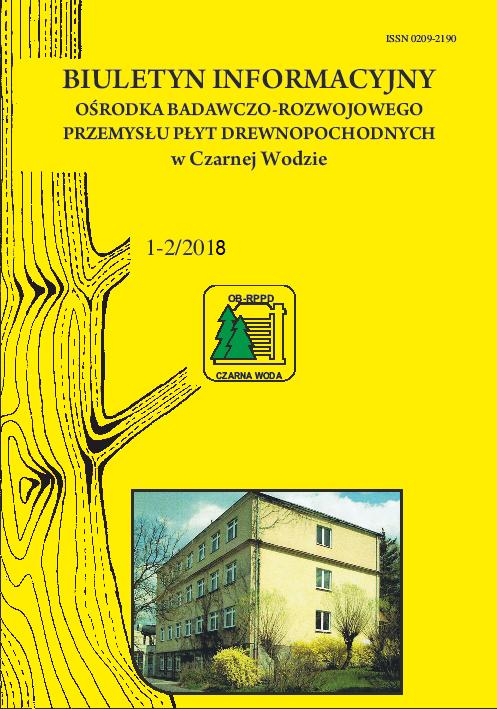
-
Biuletyn Informacyjny
Ośrodka Badawczo–Rozwojowego Przemysłu Płyt Drewnopochodnych w Czarnej Wodzie
Analiza wpływu wilgotności wiórów na proces przegrzewania kobierca płyt wiórowych
Piotr Borysiuk, Magdalena Wołkowicz
- Streszczenie
- Pełny tekst artykułu
Badano proces przegrzewania kobierców z wiórów o wilgotności nominalnej: blisko 0%, 5%, 10% i 15%. W ramach badań analizowano kobierce o gęstości docelowej 600, 700 i 800 kg/m3. Proces przegrzewania przeprowadzono w prasie jednopółkowej sterowanej komputerowo przy temperaturze półek prasy 180°C w czasie 900°s. Ustalono, że szybszemu przegrzaniu kobierca do temperatury ok. 100°C w jego wnętrzu sprzyja wyższa wilgotność wiórów oraz niższa gęstość wytwarzanej płyty. Wyższe wartości temperatury końcowej we wnętrzu kobierca (ponad 100°C) uzyskuje się w przypadku zastosowania wiórów o niższej wilgotności (poniżej 5%) oraz niższej gęstości wytwarzanej płyty. Kobierzec wytworzony z wiórów o niższej wilgotności wymaga wydłużenia etapu komprymacji w celu uzyskania założonej grubości płyty.
Innowacyjne metody zwiększania trwałości narzędzi skrawających dla przemysłu meblarskiego
Marek Barlak, Jacek Wilkowski
- Streszczenie
- Pełny tekst artykułu
W artykule przedstawiono główne materiały narzędziowe stosowane w przemyśle meblarskim i opisano metody poprawy trwałości narzędzi skrawających. W ramach metodyki badań własnych, przedstawiono przykłady modyfikowanych narzędzi, urządzenia wykorzystywane do ich modyfikacji i testowania oraz wybrane wyniki testów.
Wpływ sposobu składowania zrębków drzewnych na właściwości fizyczne i mechaniczne płyt wiórowych
Radosław Auriga
- Streszczenie
- Pełny tekst artykułu
Analyzing the impact of the storage of wood material on the physical and mechanical properties of particleboard produced is essential for well thought-out planning and operation. This allows optimize the storage time for a particular storage method. Storage time of the material significantly influences such properties as modulus of rapture, modulus of elasticity and internal bonding. The extension of storage time of the raw material causes significant deterioration aforementioned properties. The negative impact of storage time on the properties of particleboard can be reduced by storing the raw material properly. In this paper, it is concluded that in terms of properties of particleboard produced from raw material stored in open pile, storage time can be up to 6 months. However, the further stockpiling of this material negatively affects the properties of the particle board produced. Storage time of the wood material can be extended by covering the pile. However, the most advantageous way of storing raw wood material for particleboard production is storage in silo-buildings with forced air circulation. After 12 months of storage in a silo-building with forced air circulation, only a slight impact on the properties of the particleboard produced was noted.
Wybrane właściwości ultracienkich płyt HDF
Grzegorz Kowaluk, Adam Golonko, Eduardo Robles
- Streszczenie
- Pełny tekst artykułu
The aim of this work was to investigate the selected mechanical and physical properties of ultra – thin (below 2 mm thickness) HDF panels, produced in laboratory conditions. The panels were produced with 1, 1.5 and 2 mm thickness, as well as with 860 kg/m3 and 900 kg/m3 assumed density. It was found that thetested panels density increase results in improved bending properties, higher internal bond and reduced thickness swelling. The increased density gradient on the panels’ increased thickness was also observed.
Możliwość wykorzystania odpadów powstających podczas produkcji sklejki do wytwarzania tworzyw drewnopochodnych
Dorota Dziurka, Katarzyna Adamczewska
Zalety i wady drewna jako materiału w budownictwie
Maria Antoni Hikiert
- Streszczenie
- Pełny tekst artykułu
The article concisely describes the advantages and disadvantages of wood as a building material, that refer to all wood-based construction technologies. In Poland in constructions based on wood building coniferous species are used. In the conclusion we draw attention to the fact that in our country in the post-World War II period wood has had negative public relations for a comparatively long time. Its negative features have been established and are still present today, although modern wood technology knows many ways to mitigate them and even eliminate them completely.


